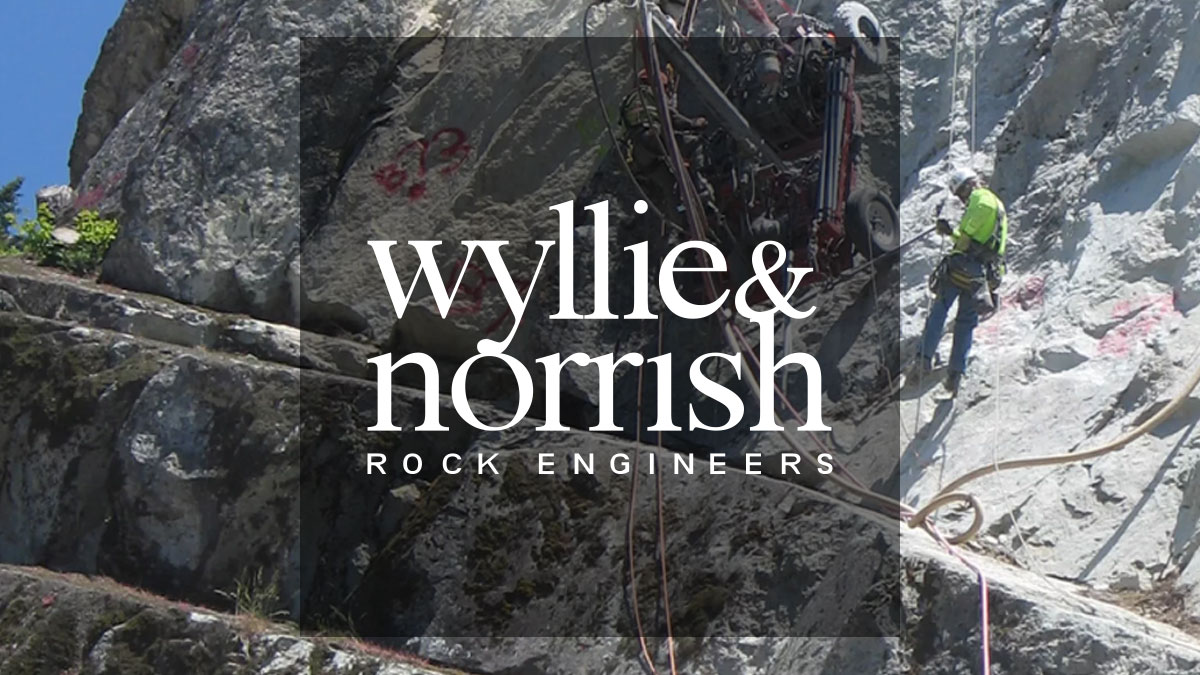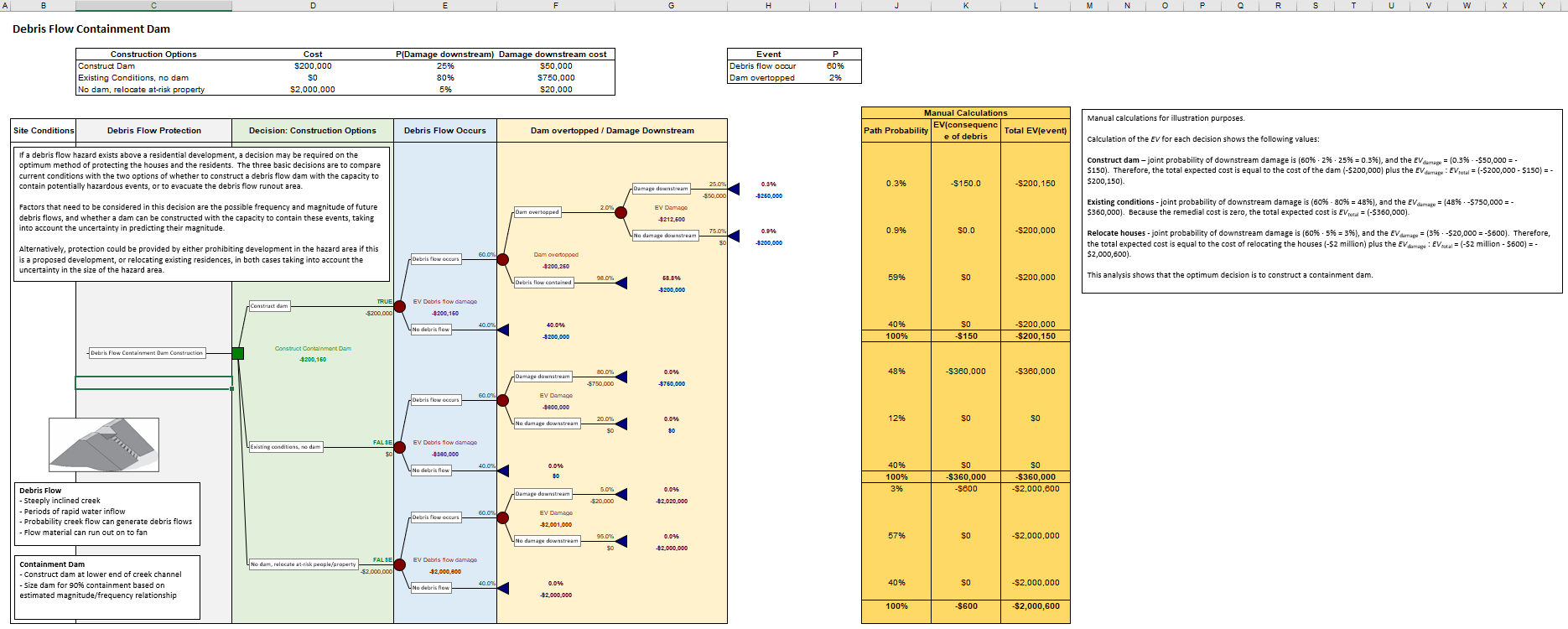
Application
Modeling the frequency and magnitude of future debris flows to determine the optimum hazard mitigation strategy. Communicating risk to clients by displaying the probability of event paths for three decisions:
- Existing conditions
- Constructing a containment dam
- Relocating existing residences
Summary
Duncan Wyllie, a Principal of Wyllie & Norrish Rock Engineers, uses the Palisade software PrecisionTree for probabilistic modeling of debris flow protection measures.
When analyzing the optimum method of protecting an area at risk from debris flows, three decisions are compared – accepting existing conditions, constructing a containment dam with sufficient capacity to contain future flows, or relocating residences on the debris flow runout area. Creating probabilistic decision trees in PrecisionTree allows uncertainties in the frequency and magnitude of future debris flows to be analyzed, and for comparison of costs between constructing a dam and relocating the residences.
Background
Wyllie & Norrish Rock Engineers, with offices in Seattle and Vancouver, Canada, is a specialist engineering company working in the fields of landslides, tunnels, slopes, and foundations. Duncan Wyllie and Norman Norrish, the company principals, have a combined total of 80 years of experience in applied rock mechanics.
Since the 1990s, Wyllie and Norrish have been utilizing Palisade software to analyze natural hazards and select hazard mitigation procedures.
Using Palisade Products
When a potential debris flow hazard is located above a residential development, PrecisionTree can be used to create a probabilistic decision tree that maps out possible scenarios, the likelihood they will occur, and the estimated damage costs. Three decisions are compared – existing conditions, constructing a debris flow dam, or evacuating the debris flow runout area.
ss
Principal of Wyllie & Norrish Rock Engineer
ss
Debris Flow Dam Decision Tree Example
With reference to the decision tree shown below, the components of the analysis are as follows:
-
- Columns 1 and 2 – Information on site conditions
- Column 3 – Three mitigation options with estimated costs for each:
- Dam construction – $200,000
- Existing conditions – $0
- Relocating houses – $2 million
- Column 4 – Probability of a debris flow occurring during the life of the project equals 60%. This is based on a study of the site including the gradient of the creek, geology of the creek bed, and rainfall intensity. This probability is the same for all options.
- Column 5 and 6 – Probability of damage downstream and damage cost, if a debris flow occurs.
- Dam constructed – 2% probability of dam overtopping, with 25% probability of damage downstream: estimated cost of damage $50,000.
- Existing conditions – 80% probability of damage with an estimated cost of damage to residences of $750,000.
- Residences relocated – 70% probability of damage to residual structures, site clean up at estimated cost of $20,000.
- Column 7 – Path probabilities of events ranging from [Povertopping = (0.6 0.02 · 0.25) = 0.3%] for dam overtopping and causing property damage, to [Pdamage existing = (0.6 · 0.8) = 48%] for damage occurring under existing conditions.
- Column 8 – Expected value (EV = probability cost) of each event ranging from:
- [EVdam = $50,000 0.003 = $150] for the dam being overtopped and causing damage, to
- (EVexisting = $750,000 0.48 = $360,000) for existing conditions.
- Column 9 – Total expected values, sum of mitigation cost plus expected damage cost
- (EVΣdam = $200,000 +$150 = $200,150) for dam construction.

For a closer look, download our free Debris Flow Containment Dam example model.
Analysis shows that the optimum decision is to construct a containment dam because the total cost of mitigation plus the expected cost (EV) of damage is lower for the dam construction (EVΣdam = $200,150) than for existing conditions (EVΣexisting = $360,000) or for relocating the houses (EVΣhouses = $2,000,600).
Results
The use of PrecisionTree allows possible mitigation measures, along with the probability of event occurrence and cost, to be analyzed. The analysis unambiguously identifies the most cost-effective mitigation measure, and the decision process is clearly mapped out in the decision tree.
A Competitive Edge
The use of @RISK and PrecisionTree software to prepare decision trees modeling all potential outcomes enables Wyllie & Norrish Rock Engineers to quantitatively determine the optimum protection strategy and easily communicate the findings.
With Palisade’s products, Wyllie & Norrish Rock Engineers can:
- Calculate all possible scenarios with Monte Carlo simulations
- Easily communicate risk to clients with PrecisionTree
- Recommend the optimal protection decision
By using probabilistic analysis, Wyllie & Norrish Rock Engineers ensure that the best decision is reached for each at-risk area and if necessary, effective debris flow dams are created to protect nearby structures.
Free Example Models
Download our free example model, Decision Trees in Geotechnical Engineering, to explore three decision tree examples from the geotechnical engineering field: debris flow containment dam, rock slope stabilization, and gravity dam reinforcement anchors.
